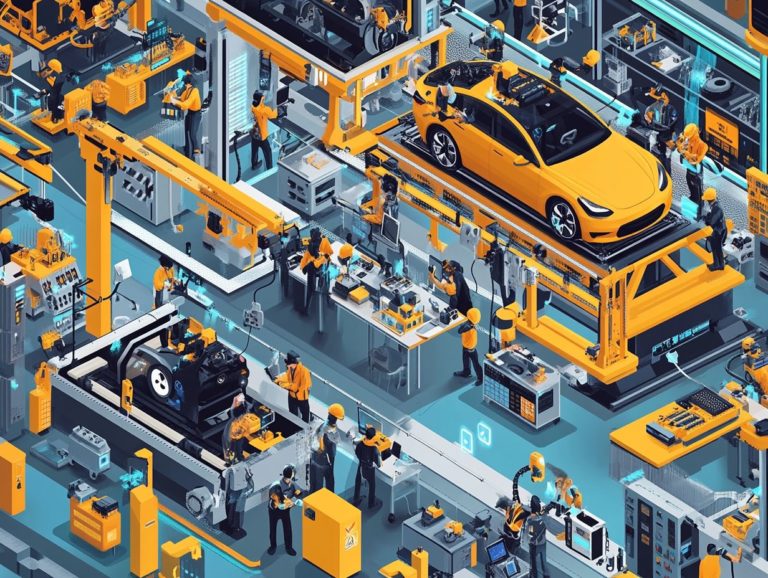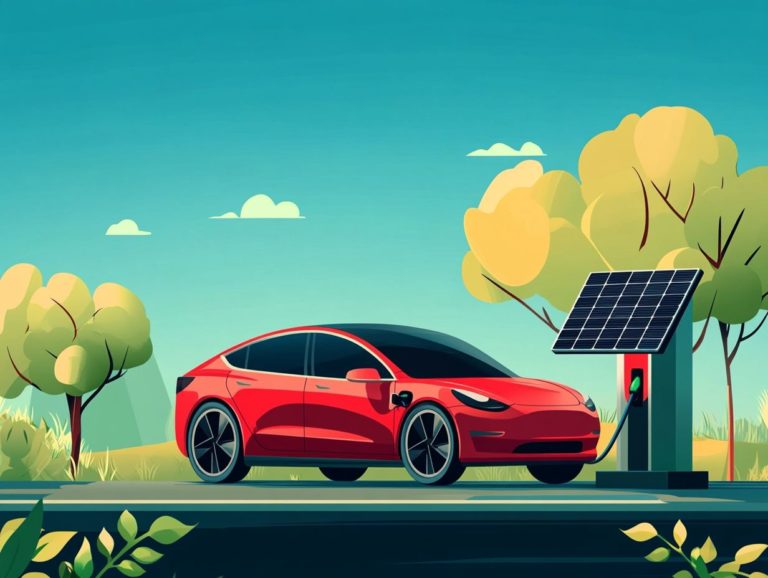The Future of Autonomous Electric Vehicles
Get ready to explore the rise of autonomous electric vehicles (AEVs)! This transformative shift in transportation blends cutting-edge technology with eco-friendly solutions that are set to redefine your mobility experience.
This article showcases the definition and various types of AEVs, highlighting their current advancements and the challenges they encounter. You ll discover the significant environmental and economic benefits they bring, envisioning a future influenced by technological innovations.
Obstacles like regulatory hurdles and infrastructure gaps remain. Join us as we uncover the profound implications AEVs hold for industries and urban planning, shaping a sustainable and efficient future.
Contents
- Key Takeaways:
- Discover the Future of Autonomous Electric Vehicles!
- Current State of Autonomous Electric Vehicles
- Benefits of Autonomous Electric Vehicles
- Future of Autonomous Electric Vehicles
- Obstacles to Widespread Adoption
- Impact on Industries and Society
- Frequently Asked Questions
- What are autonomous electric vehicles?
- What is the future of autonomous electric vehicles?
- How do autonomous electric vehicles work?
- What are the benefits of autonomous electric vehicles?
- What are the challenges facing the future of autonomous electric vehicles?
- Will Autonomous Electric Vehicles Replace Traditional Vehicles?
Key Takeaways:

- Autonomous electric vehicles are self-driving cars that run on electricity. They vary in type and how much self-driving capability they have!
- Advancements in technology and environmental benefits make autonomous electric vehicles the future of transportation. However, regulatory and infrastructural challenges hinder widespread adoption.
- The future of autonomous electric vehicles promises a more sustainable and efficient transportation system, impacting industries and society in terms of urban planning and mobility.
Discover the Future of Autonomous Electric Vehicles!
Autonomous electric vehicles represent a groundbreaking advancement in the automotive transport sector. They embody a seamless blend of self-driving features and sustainability. By integrating self-driving capabilities with electric power, these intelligent vehicles are reshaping your driving experience and revolutionizing traffic management and fuel efficiency, paving the way for the future of transportation.
Research from McKinsey suggests that autonomous electric vehicles can significantly reduce CO2 emissions, human error, and pollution, ultimately paving the way for a safer and more efficient transportation ecosystem tailored for you!
Definition and Types
Autonomous vehicles are cars equipped with artificial intelligence, allowing them to navigate without human intervention, while electric vehicles rely on electric power for propulsion.
These technologies are transforming modern transportation and introducing varying degrees of automation. The spectrum ranges from Level 0, where you re fully in control, to Level 5, which embodies full automation a vehicle that drives itself in any situation without your input.
Levels 1 through 4 include features like adaptive cruise control and lane-keeping assistance. These work beautifully with electric vehicles to enhance safety and efficiency. As more electric models come equipped with advanced driver assistance systems (ADAS), they not only help reduce environmental impact but also significantly minimize accident risks.
This showcases a seamless fusion of technology designed to enhance your driving experience!
Current State of Autonomous Electric Vehicles
The current landscape of autonomous electric vehicles presents a dynamic environment marked by remarkable technological advancements. As we explore the future of EVs in public transportation, challenges persist, particularly concerning safety and regulatory frameworks.
As industry leaders such as Tesla, BMW, and Audi innovate with their intelligent vehicles, the integration of communication controls and traffic management systems becomes essential for ensuring safe navigation!
Advancements and Challenges
Recent advancements in autonomous vehicles have introduced enhanced communication controls that facilitate seamless interactions between vehicles and infrastructure. This significantly elevates traffic management and safety.
These innovations are fueled by smart computer programs that analyze real-time data, allowing for optimized routes and reduced congestion. However, this rapid development brings significant challenges, particularly the necessity for regulatory support to establish safety standards and address public concerns regarding reliability.
As autonomous technology continues to evolve, it opens doors for improved pollution control, promising a noteworthy reduction in CO2 emissions. By integrating embedded systems that monitor and manage emissions in real time, these vehicles could play a pivotal role in fostering a more sustainable future while alleviating the strain on urban infrastructure.
Benefits of Autonomous Electric Vehicles

Autonomous electric vehicles offer a wealth of benefits that transcend the realm of transportation enhancements. They stand to deliver significant economic advantages, environmental improvements, and optimized vehicle usage.
By minimizing human error and refining driving patterns, these vehicles promise remarkable fuel savings and reduced maintenance expenses. They also play a vital role in pollution control by lowering overall emissions in urban environments.
Environmental and Economic Impact
The environmental and economic impact of autonomous vehicles is truly remarkable. They offer the potential for substantial reductions in CO2 emissions and significant fuel savings, translating into cost efficiency that benefits both individuals and businesses alike.
By optimizing routes and minimizing idle time, these vehicles can effectively decrease overall fuel consumption. This leads to a noticeable decline in greenhouse gas emissions. As the adoption of electric autonomous vehicles accelerates, the transition toward cleaner energy sources is poised to gain traction, nurturing a green economy.
Increased investment in the electric vehicle market stands to stimulate job growth within renewable energy sectors, bolstering economic resilience. Now is the time to invest in electric vehicles to boost job creation and protect our planet.
You can expect to enjoy lower maintenance costs and reduced fuel expenses, while governments may witness a decline in infrastructure spending associated with traffic congestion and pollution control. Ultimately, this shift contributes to a healthier planet and a more robust economy.
Future of Autonomous Electric Vehicles
The future of autonomous electric vehicles is poised to undergo remarkable transformation driven by swift technological advancements. Get ready for a thrilling shift in how we travel, as highlighted in the future of sustainable mobility and electric vehicles!
Innovations in vehicle cloud technology will empower seamless connectivity and data sharing among vehicles and infrastructure, significantly enhancing both safety and operational efficiency.
This evolution promises not only to revolutionize transportation as you know it but also to elevate your driving experience to new heights.
Exciting Tech Developments Shaping the Future!
Technological advances in autonomous electric vehicles are paving the way for enhanced capabilities and setting the stage for predictions about their widespread adoption. With innovations in vehicle cloud systems and advanced driver assistance technologies, you’re looking at a future where these vehicles could be a common sight on the roads.
These developments are expected to significantly reshape the transportation landscape, promising improved travel efficiency and heightened roadway safety. Imagine the impact of real-time data and machine learning algorithms on vehicle operations this could lead to navigation and decision-making systems that are more reliable than ever, ultimately fostering greater public trust in autonomous technology.
As more individuals begin to recognize the advantages of these vehicles, discussions around safety regulations will naturally evolve. Policymakers are likely to adjust frameworks to accommodate this transformative era. Public acceptance is on the rise, likely influencing future mobility trends where autonomous vehicles become integral members of urban environments.
Obstacles to Widespread Adoption
Despite the promising potential of autonomous electric vehicles, several obstacles stand in the way of their widespread adoption. Regulatory challenges (rules and laws governing safety and use) and infrastructural barriers must be meticulously addressed to ensure their safe integration into existing traffic systems.
Regulatory and Infrastructural Challenges

Regulatory and infrastructural challenges present significant hurdles for the advancement of autonomous vehicles. Safety regulations vary widely across regions, often leading to confusion for both manufacturers and consumers.
For instance, the European Union is working to harmonize regulations to spur innovation. In contrast, the United States has opted for a patchwork approach, allowing individual states to create their own rules. This inconsistent framework can hinder the deployment of autonomous vehicles, forcing companies to navigate a complex maze of varying standards.
Countries like Japan have adopted more cohesive regulatory models, facilitating smoother integration and development of these technologies. Synchronizing regulations across borders is increasingly vital, as it simplifies the path for manufacturers and instills consumer confidence in the safety and functionality of these groundbreaking vehicles.
Impact on Industries and Society
The impact of autonomous electric vehicles on various industries and society as a whole is profound. They are poised to revolutionize transportation systems and play a vital role in shaping urban planning and influencing trends in mobility behavior.
Implications for Transportation and Urban Planning
The implications of autonomous electric vehicles on transportation and urban planning are significant. They prompt a reevaluation of existing infrastructure and mobility behaviors to fully tap into their potential.
As an urban planner, consider how these vehicles will integrate into city landscapes. This means upgrading roads, parking facilities, and charging stations. Such evolution may lead to reevaluating zoning laws, allowing traditional parking spaces to be transformed into vibrant green areas, pedestrian walkways, or bike lanes.
You can enhance public transportation strategies by integrating autonomous vehicles into existing systems, paving the way for a seamless shared mobility model. As congestion decreases and accessibility improves, cities will become more livable, fostering community engagement and spurring economic growth in areas that have long been overlooked.
Frequently Asked Questions
What are autonomous electric vehicles?
Autonomous electric vehicles drive themselves and are powered by electric motors instead of traditional gasoline engines.
What is the future of autonomous electric vehicles?

Get ready for a future where autonomous electric vehicles will transform the transportation industry! Expect significant changes, including reduced carbon emissions, increased safety, and improved efficiency, as highlighted in the future of electric vehicles in sustainable cities.
How do autonomous electric vehicles work?
These vehicles use a combination of sensors, cameras, and artificial intelligence to navigate and make decisions while driving. They rely on data and algorithms to analyze their environment and make real-time adjustments.
What are the benefits of autonomous electric vehicles?
Benefits include reduced carbon emissions, improved traffic flow, increased safety, and lower operating costs due to cheaper fuel and maintenance expenses.
What are the challenges facing the future of autonomous electric vehicles?
Challenges that must be addressed before these vehicles become mainstream include regulatory hurdles, infrastructure development, cybersecurity concerns, and public acceptance and trust.
Stay informed about autonomous electric vehicles and engage in discussions about their future!
Will Autonomous Electric Vehicles Replace Traditional Vehicles?
Autonomous electric vehicles could soon take over traditional cars! For insights on this shift, check out the future of renewable energy and EVs. The full transition might take some time, though.
New technology, costs, the availability of charging stations, and what consumers want will shape this exciting change.






